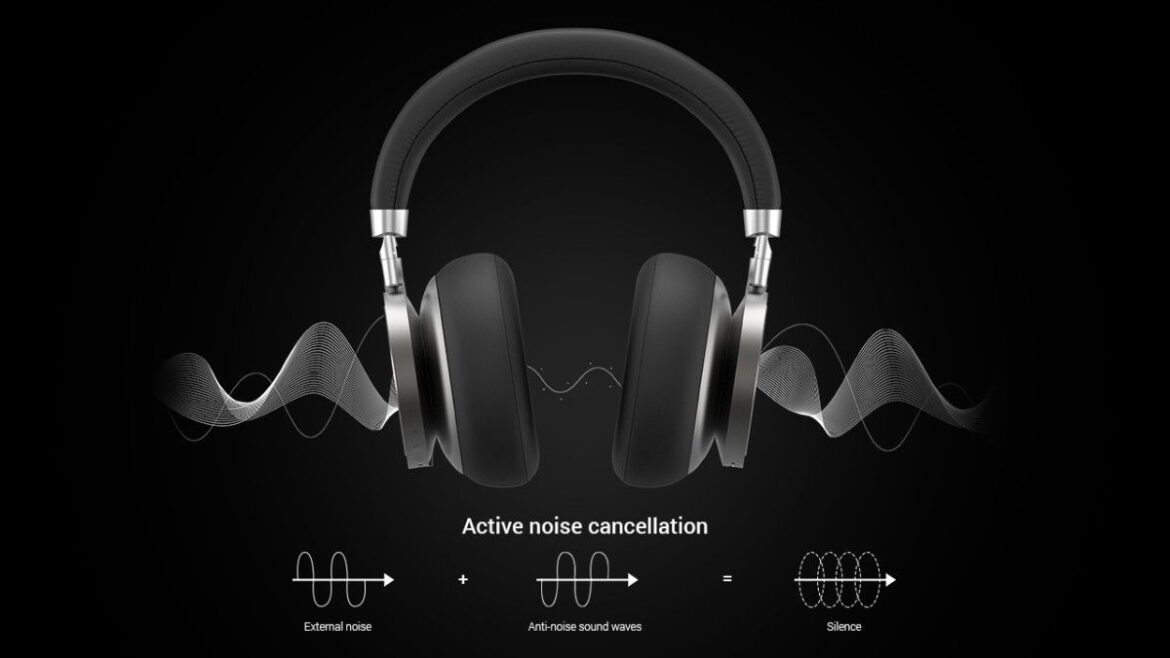Have you ever found yourself in a bustling coffee shop, a noisy airplane, or even just a busy home, wishing you could hit a mute button on the world around you? If you’re a headphone enthusiast, you know that the struggle to find true peace and quiet for your music, podcasts, or even just your thoughts is real. That's where noise cancellation technology swoops in like a superhero!
This isn't just about turning up the volume to drown out distractions; it's about making those distractions disappear, almost as if by magic. In this ultimate guide, we're going to dive deep into what noise cancellation is, how it works, and why it's become a must-have feature for anyone serious about their audio experience. So, buckle up!
Key Takeaways
- Two Main Types: Noise cancellation comes in two main forms: Passive Noise Cancellation (PNC), which uses physical barriers, and Active Noise Cancellation (ANC), which uses technology to cancel out sound waves.
- ANC's Magic: Active Noise Cancellation works by using microphones to pick up ambient noise and then creating an "anti-noise" sound wave that cancels out the original noise.
- Big Benefits: This technology helps you focus better, reduces stress, protects your hearing by letting you listen at lower volumes, and makes travel much more enjoyable.
- Choosing Wisely: When picking noise-cancelling headphones, consider the type of noise you want to block, comfort, battery life, sound quality, and your budget.
- Not Total Silence: While powerful, noise cancellation doesn't create complete silence; it significantly reduces low-frequency, constant hums, but some sounds like voices might still get through.
What is Noise Cancellation?
Alright, let's kick things off with the basics. What exactly is noise cancellation? At its core, it's a technology designed to reduce unwanted ambient sounds. Think of it as your personal bubble of quiet, no matter where you are. It’s different from just having headphones that cover your ears well (though that helps!). Noise cancellation actively works to make the world quieter.
Ever tried to focus on a book or a conversation in a really loud place? It's tough, right? Noise cancellation aims to solve that problem, giving you a calmer, more focused environment.
The Two Pillars: Passive vs. Active Noise Cancellation
When we talk about noise cancellation, we're usually talking about one of two main types: Passive Noise Cancellation (PNC) and Active Noise Cancellation (ANC). Both aim to reduce noise, but they go about it in very different ways.
1. Passive Noise Cancellation (PNC)
This is the simpler of the two, and honestly, you've probably experienced it without even thinking about it. Passive Noise Cancellation is all about creating a physical barrier between your ears and the outside world.
- How it Works: Imagine putting on a thick pair of earmuffs or sticking your fingers in your ears. That's PNC in action! It uses materials like dense foam, silicone, or even just the snug fit of an over-ear headphone to block sound waves from reaching your eardrums.
- Examples:
- Earplugs: The classic example. They physically block sound.
- Over-ear headphones: Many headphones, especially those with large, padded earcups, offer good passive noise isolation just by forming a seal around your ears.
- In-ear monitors (IEMs): These fit snugly into your ear canal, creating a seal that naturally blocks a good amount of external noise.
- Strengths:
- Doesn't require batteries.
- Effective at blocking high-frequency sounds (like chatter or a baby crying).
- Always "on."
- Weaknesses:
- Less effective against low-frequency hums (like airplane engines or bus noise).
- Can sometimes feel bulky or uncomfortable.
So, if you’re looking to block out sharp noises, PNC is pretty good. But for that deep, rumbling drone, you need something more advanced.
2. Active Noise Cancellation (ANC)
Now, this is where the real magic happens! Active Noise Cancellation is a much more sophisticated technology that doesn't just block sound; it cancels it out.
- How it Works: Here's the thing: sound travels in waves. ANC technology uses tiny microphones to listen to the ambient noise around you. Once it "hears" a sound wave, it quickly creates its own opposite sound wave, often called "anti-noise." When these two waves (the original noise and the anti-noise) meet, they essentially cancel each other out. This process is called destructive interference. It's like adding +1 and -1 to get zero!
- Components of ANC:
- Microphones: To pick up ambient noise.
- ANC Chip: A special processor that analyzes the noise and generates the anti-noise signal.
- Speakers: To play the anti-noise signal into your ears, along with your music.
Let's break down the different types of ANC because, actually, there isn't just one way to do it:
Feedforward ANC:
- How it works: Microphones are placed on the outside of the earcup, listening to the world before the sound even reaches your ear.
- Pros: Good at reducing a wide range of frequencies, especially mid-to-high ones.
- Cons: Can sometimes struggle with sudden changes in noise. Doesn't correct for noise that might leak into the ear from inside the earcup.
Feedback ANC:
- How it works: Microphones are placed inside the earcup, near your ear. They listen to the sound that actually reaches your ear (including your music) and adjust the cancellation based on that.
- Pros: Very effective at canceling out low-frequency noise (like that annoying hum of an AC unit) and can adapt better to how the headphones fit your head. It also corrects for any noise that might get past the passive seal.
- Cons: Can sometimes accidentally cancel out parts of your music if not designed well. More prone to "feedback" if the microphone is too close to the speaker.
Hybrid ANC:
- How it works: This is the best of both worlds! It combines both feedforward and feedback microphones.
- Pros: Offers the most comprehensive noise cancellation across a wider range of frequencies. It's highly adaptable and generally provides the best overall experience.
- Cons: More complex and usually more expensive due to the extra microphones and processing.
Image Suggestion: A simple infographic showing sound waves. One wave moving from left to right, then an identical wave mirrored vertically (the anti-noise wave) moving towards it. An arrow pointing to where they meet, resulting in a flat line (silence). Title: "How Active Noise Cancellation Works: Destructive Interference."
The Benefits of Noise Cancellation
So, beyond just being cool tech, why is noise cancellation such a big deal, especially for us headphone enthusiasts? Honestly, it's a game-changer for several reasons:
- Uninterrupted Focus: Imagine trying to study, work, or concentrate on a complex task. Noise cancellation creates a quiet sanctuary, allowing you to dive deep without distractions. No more barking dogs, noisy neighbors, or office chatter breaking your flow.
- Enhanced Audio Experience: With less background noise, your music, podcasts, and audiobooks sound clearer and richer. You'll pick up on details you never noticed before. It's like listening to your favorite track in a soundproof studio!
- Hearing Protection: This is a big one! When you're in a noisy environment, you naturally turn up the volume to hear your audio. With noise cancellation, you don't need to crank it up as much, which is much better for your long-term hearing health.
- Stress Reduction: Constant noise exposure can be incredibly stressful. Noise-cancelling headphones can provide a sense of calm and escape, reducing anxiety levels and making your commute or travel much more relaxing.
- Improved Travel: Airplanes, trains, and buses are notorious for their low-frequency hums. ANC headphones make these journeys significantly more comfortable, allowing you to sleep, work, or simply enjoy the ride in peace.
- Better Sleep (for some): While not their primary purpose, some people use ANC headphones (without music) to block out nighttime disturbances like snoring or city noise, helping them get better rest.
Pull Quote: "Noise cancellation isn't just a feature; it's an experience. It transforms noisy environments into personal soundscapes where your audio truly shines."
Choosing Your Quiet Companion: What to Look For
Ready to dive into the world of quiet? Great! But with so many options out there, how do you pick the right noise-cancelling headphones? Here are some key factors to consider:
- Type of Noise You Want to Block:
- Constant hums (planes, trains, AC): Hybrid ANC is your best friend here.
- Voices/chatter: While ANC helps, remember it's less effective on higher, unpredictable frequencies like human speech. Good PNC also plays a role here.
- Sudden noises: ANC isn't perfect for sudden, sharp sounds like a car horn, but it will still reduce their impact.
- Sound Quality: Even with amazing noise cancellation, you still want your music to sound good, right? Look for headphones known for balanced audio, clear highs, and deep bass. Read reviews from trusted sources like 10 Best Noise Cancelling Headsets with Mic for Working From Home for insights.
- Comfort and Fit: You'll be wearing these for extended periods, especially during travel. Make sure they're comfortable, lightweight, and have soft earcups. Over-ear headphones often offer the best comfort for long sessions.
- Battery Life: ANC requires power. Check how long the battery lasts with ANC enabled. Many modern headphones offer 20-30+ hours, which is great for long flights.
- Portability: Do you need them to fold up neatly for travel? Are they lightweight enough to carry around all day?
- Extra Features:
- Transparency Mode (or Ambient Sound Mode): This lets in outside sound when you need to hear your surroundings (e.g., announcements at an airport or talking to a cashier). It’s super handy!
- App Control: Many headphones come with companion apps that let you customize ANC levels, adjust EQ settings, and more.
- Bluetooth Connectivity: Ensure they support the latest Bluetooth standards for stable connections.
- Call Quality: If you plan to use them for calls, check reviews on microphone performance.
- Price: Noise-cancelling headphones range from budget-friendly to premium. Set a budget, but remember that investing in a good pair can significantly enhance your daily life.
Table Suggestion:
| Feature | What to Look For | Why it Matters |
|---|---|---|
| ANC Type | Hybrid ANC for overall best performance | Different types excel at blocking different frequencies. |
| Comfort | Padded earcups, adjustable headband, lightweight | Essential for long listening sessions and travel. |
| Battery Life | 20+ hours with ANC on | You don't want them dying mid-flight or workday. |
| Sound Quality | Balanced audio, clear highs, deep bass | The primary purpose is still great audio. |
| Transparency Mode | Ability to hear surroundings with a button press | Safety and convenience for quick interactions. |
| Portability | Foldable design, sturdy carrying case | Easy to pack and protect when you're on the go. |
| Price | Aligns with your budget, considering features vs. cost | Good value for money, balancing performance with affordability. |
Common Myths and Misconceptions About ANC
Let's clear up a few things. There are some common misunderstandings about noise cancellation:
- "It creates complete silence." Nope! While it's incredibly effective, ANC mainly targets low, constant frequencies. You'll still hear some higher-pitched sounds like alarms, sudden loud bangs, or very close voices, though they will be muffled. It's about significant reduction, not absolute silence.
- "It's bad for your ears." Absolutely not! In fact, it can be better for your ears. By reducing background noise, you don't need to turn your music up as loud, which protects your hearing in the long run.
- "It makes you feel dizzy or pressured." For some very sensitive individuals, especially with older ANC tech or certain types of ANC, a slight "pressure" feeling can occur. However, modern hybrid ANC systems have largely minimized this, making it a non-issue for most people.
- "It only works with music playing." False! You can use ANC headphones just for the quiet, even without playing any audio. Many people do this to focus, meditate, or just find peace in a noisy environment.
The Future of Quiet: What's Next for Noise Cancellation?
The world of noise cancellation isn't standing still. Manufacturers are constantly pushing the boundaries. What can we expect next?
- Smarter, Adaptive ANC: Headphones that automatically adjust the level of noise cancellation based on your environment. Imagine walking from a quiet office to a busy street, and your headphones seamlessly change their ANC settings.
- Personalized Soundscapes: Beyond just cancelling noise, future tech might allow you to mix in specific ambient sounds (like rain or forest noises) to create your perfect personalized audio bubble.
- Better Voice Isolation: While current ANC is great for environmental noise, improving the cancellation of human voices specifically for calls or even just for your own peace will be a big step forward.
- Smaller and Lighter Designs: As technology advances, we'll likely see even more powerful ANC packed into smaller, more comfortable form factors, especially for true wireless earbuds.
Anyway, the possibilities are exciting!
Keeping Your Quiet: Maintenance Tips
To make sure your noise-cancelling headphones last and keep performing their best, a little care goes a long way:
- Keep them clean: Wipe down the earcups and headband regularly with a soft, dry cloth. If your earcups are removable, you might be able to clean or replace them.
- Protect the microphones: The tiny microphones for ANC are crucial. Avoid getting them wet or dirty.
- Store them properly: Use the carrying case if one came with your headphones. This protects them from dust, dirt, and physical damage.
- Mind the battery: Don't leave them fully discharged for long periods. Try to keep some charge in the battery even when not in use.
Conclusion
So, there you have it: The Ultimate Guide to Noise Cancellation Technology. From the simple physical barrier of passive noise cancellation to the sophisticated anti-noise magic of active noise cancellation, this tech is truly transforming how we experience sound. For headphone enthusiasts, it's not just a luxury; it's a tool that enhances focus, protects hearing, and makes every listening session, commute, or quiet moment infinitely better.
Whether you're battling the drone of an airplane engine, the chatter of an open office, or just seeking a moment of peace, noise-cancelling headphones are your ticket to a calmer, clearer world. Go ahead, give them a try – your ears (and your sanity!) will thank you.
Want to stay updated on the latest tech trends and headphone reviews? Be sure to connect with us! You can find more insights on our main blog at Techozea, follow our updates on Twitter, see our latest posts on Instagram, discover more on our Pinterest boards, and connect with us on Facebook.




